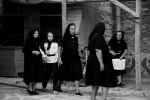
Săpânţa/Szaplonca/Sapunka/Spinka - a little village - not to say bushes - in Maramureş county, north Romania, almost at the border with Ukraine. Possibly, no one would ever know about Săpânţa if not for one cemetery. Even if it sounds weird, tourists from all over the world come here just to visit the cemetery! You may think that some celebrity like Jim Morrison is buried here? Not at all. These are just ordinary people who lived their quiet lives in this small, Romanian village, lay here. What is special about the cemetery then, you may ask? Well, the cemetery in Săpânţa is a jolly one!
ATTENTION! Everyone who visited Romania or is planning to go there soon is kindly invited to contribute to this guide. Any inquires regarding this matter should be referred to the editor's address redakcja@libertas.pl.
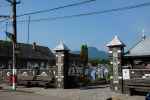
In Europe death is usually seen as black, sad and teary-eyed... Săpânţa, however, seems not to obey this rule. We enter the cemetery through a colourful gate and right away we dive into a sea of joyful colours of wooden tombstones, meeting people who do not look like mourners going frantic. The one responsible for this weird order of things is Ioan Stan Patraş, the local artist, who carved his first, happy tombstone in 1935. Apparently, this way of immortalizing close ones commended the countrymen a lot - until the artist died in 1977, the colourful gravestones were easily seen in the whole cemetery. The custom has perpetuated to such an extent, that after the Patraş's death, his student, Dumitru Pop took his place. He lives in the village to this day, continuing the creation of his master.


It is common in Europe to see memorials made of durable material like marble and granite. Here, oak, roofed crucifixes tower over the Merry Cemetery. The next common thing about cemeteries in Europe is their seriousness, with black or grey gravestones. Not the same as in the Merry Cemetery! It is the blue colour which clearly dominates. Its characteristic hue ended up having a special name, Săpânţa Blue. Scenes from occupants' lives can be easily seen on this pleasant, if not heavenly, canvas. We can see how were they earning their livings. We can see militants, tractor drivers, butchers, vets, chemists, weavers... Though not every gravestone could be deciphered so easily.

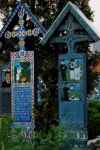
Thanks to this cartoonish and original way tourists find out who they were, what their weaknesses like smoking and drinking were. We can even get to know the circumstances of their deaths. One of the most popular crucifixes tells a story about a 3 year old girl who died in a car accident. Another one shows a soldier who's head was cut off by a Hungarian soldier probably after being shot down! If it was not enough, this naive, sometimes brutal but nice paintings, are accompanied by epitaphs greatly deviating from serious farewells we are used to. For example, texts like: Underneath this heavy cross|Lies my mother-in-law poor|Had she lived three days more|It would be me who's laid here. Everything is beautifully done and well decorated with flowery and geometric motifs. To put it simply, each of these crucifixes is a unique masterpiece. All together they create the most unusual portrait of this small community, which, even after death, lasts so improperly alive!

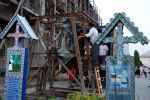
For sure, Ioan Stan Patraş conveyed his fellow citizens something more than just a tourist attraction, which makes Săpânţa so rich and famous. It can be said that his neighbours were given a second life or that he even made thoughts about death a bit more comfortable... Well, everyone would like to have such a wonderful and original tombstone. Thanks to all he has done for Săpânţa, a museum was opened in his name.
This tombstone has grabbed my attention in a special way. The first thought was a girl dancing in bliss. She's scantly dressed, wearing red underwear and has a red heart on her legs. There are also two faces looking at her from a side. A very interesting composition, isn't it? But what about these angel wings? I was trying to fit the pieces together, assuming that dance was her profession and that she was also an angel...
I thought that my doubts can be resolved by the epitaph, so I asked for translation. Unfortunately, this specific tombstone was created by a student of Ioan Stan Patraş - not as literately talented as the master. In addition, the lack of punctuation was not simplifying me the task. Some of the words are not used today as well. As a result, we cannot exactly interpret the text and we do not find out how old she was or what was her profession.

COPILĂRIE CE-AM AVUT PREA PUŢINĂ MIO CĂZUT NU MO LĂSAT SĂ TRĂIESC PÂRINTI SĂ NUI GRUMBESC MI-O FOST MUSAI A PLECA CA SÂ-MI PĂRĂSESC SORA SORA DRAGĂ CÎT TRĂIEŞTI MORMÎNTUL SĂ MIL PLIEŞTI PE MORMÎNT SĂ-MI PUI FLORI SĂ NU MA UIŢI PÎNÂ MORI CAI AVUT O SORĂ BUNA ŞI N-AM PUTUT FI-NREUNÂ CA FOST MUSAI CASĂ MOR SĂ ÎMI DUCEŢI A MEU DOR
I could not enjoy the short childhood I had. I was not allowed to live. My parents could not listen to my rants. I had to go away, leave them and my sister. Dear sister, till you're alive, take care of my grave, bring flowers and never forget your good sister. We could not be together since I had to die. Miss me.1
Compare this with a tombstone by Ioan Stan Patraş with a rhymed epitaph, which goes like this:

Here is where I rest And Pop Toader is my name. I used to love the clarinet And the tuica (brandy) in my glass As long as I lived on Earth I kept thinking of these things: To have what to drink and what to eat And to play the clarinet I was also miserable Cause I was a widower But for you I am singing merryly Not the way I am singing for myself.2
The brick Church from 1886 is situated just next to the cemetery. Unfortunately, renovation was taking place during our trip and the scaffolding was blocking the view. As the mass finished, we could hear the voice of choir. We decided to come in to watch and listen.
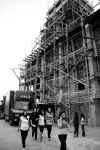
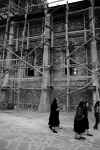
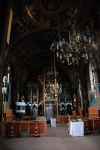
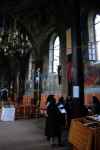
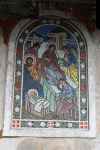
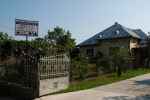
Săpânţa was revealed to the world by a French traveller, the first who used the name le gai cimetiere - The Merry Cemetery. Since that time the village is being visited more and more each year. Even if there are no five star hotels, but instead, a lot of charming guest houses. We asked for a B&B by the gate leading to the cemetery. A nice girl offered to ask on behalf of us. I guess she phoned the best guest house3 in Săpânţa and when it turned out that there are no rooms left, she found another one - equally nice - Miuta Guest House. Just after a while a car arrived and picked us up.
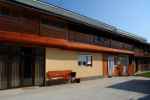
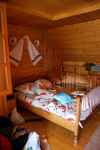

It's easy to get there. As you leave the cemetery, you need to go right, towards the main street. Just after a small bridge you go left and there's a road with an information board. We paid 80 lei for a room for four people, with a bathroom and two big beds. The room was cosy and clean; our hosts were very friendly. When the oldest grandmother found out that we were Polish, she kept chatting us up in Russian. Simply speaking, it was cheap, colourful and pleasant. Of course, there are more such B&Bs.
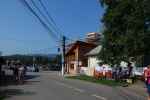
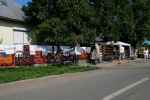
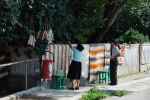
Săpânţa, like every other place besieged by tourists, is full of stalls where you can buy any souvenir you want, from wooden rattles for a leu to kitsch 'made in China' toys and handmade rugs, tablecloths and carpets.
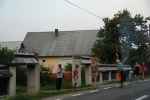

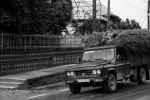
The shortest way from Poland to Săpânţa goes through Ukraine. Unfortunately, we have to cross the Ukrainian border twice, what results in queueing and can lengthen the travel by 2 or even 4 hours. If we decide to travel through Slovakia and Hungary, then it is possible to cross the border at the Csenger/Petea crossing. Then we take the 19A to Satu Mare and then we turn North-East onto the 19/Baia Mare. Then straight ahead through Negreşti-Oaş. This route is almost 100 km (60 miles) to Săpânţa.
This translation is based on Polish translations by Bożena Lazar and Joanna Suciu. A big thank you to both Ladies for the translations and a few other helpful tips.
Translation taken from: www.visitmaramures.ro.
Unfortunately, I do not remember the name of the guest house, but it is situated about 3 km from the cemetery, going the opposite way from the main road. The road was terrible as we were there in 2010! The maximum speed was 10, maybe 20 hm/h. We went there for a late dinner. I can honestly say that the food was yummy and not so expensive. If you're not put off by the holly road, then it's worthy to fill up there.
Na tematy związane z artykułem można porozmawiać na forum w wątku Sapanta.
Rumunia - przewodnik:
Satu Mare / Satmar (Romania) – guidebook (52 zdjęcia)Săpânţa - The Merry Cemetery (Romania) – guidebook (35 zdjęć)Bârsana Maramureş (Romania)– guidebook (48 zdjęć)Humor / Mănăstirea Humorului and Voronet / Voroneţ (Romania) – guidebook (32 zdjęcia)Arbore and Sucevita Monastery / Mănăstirea Suceviţa (Romania) – guidebook (43 zdjęcia)Cacica (Romania) – guidebook (21 zdjęć)Vama Veche (Romania) – guidebook (94 zdjęcia)Brasov (Romania) – guidebook (68 zdjęć)Curtea de Argeş (Romania) – guidebook (31 zdjęć)The Transfagarasan Road / Transfăgărăşan – guidebook (68 zdjęć)Sibiu / Hermannstadt (Romania) – guidebook (86 zdjęć)Hunedoara / Vajdahunyad (Romania) – guidebook (57 zdjęć)Bear Cave / Peştera Urşilor (Romania) – guidebook (29 zdjęć)Ştefan Hruşcă – kolędnik z SiedmiogroduSighetu Marmației (Romania) – guidebook (9 zdjęć)Kościoły Obronne Siedmiogrodu (Rumunia) – przewodnik (25 zdjęć)Rimetea / Torocko at the Rock of Szeklers (Romania) – guidebook (21 zdjęć)Konstanca / Constanța (Rumunia) – przewodnik (22 zdjęcia)Sighișoara (Romania) – guidebook (28 zdjęć)Mărginimea Sibiului (Romania) – guidebook (41 zdjęć)Wąwóz Galbeny / Cheile Galbenei (Rumunia) – przewodnik (23 zdjęcia)Twierdza Ponoru / Cetatile Ponorului (Rumunia) – przewodnik (19 zdjęć)Płaskowyż Padisz / Padiș (Rumunia) – przewodnik (52 zdjęcia)Wąwóz Râmeț / Cheile Râmețului (Rumunia) – przewodnik (29 zdjęć)Góry Fogaraskie – wokół jeziora Bâlea (Rumunia) – przewodnik (24 zdjęcia)